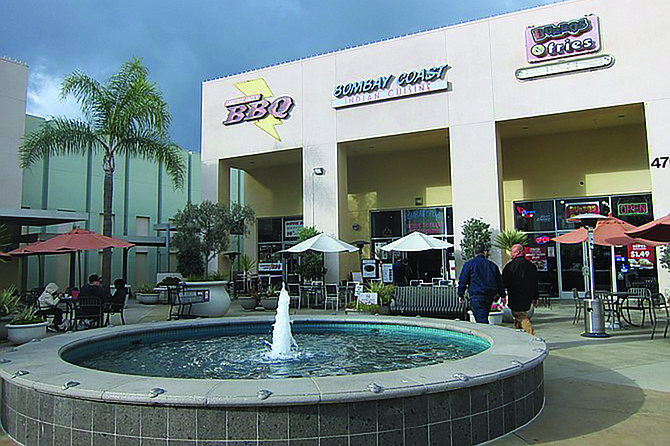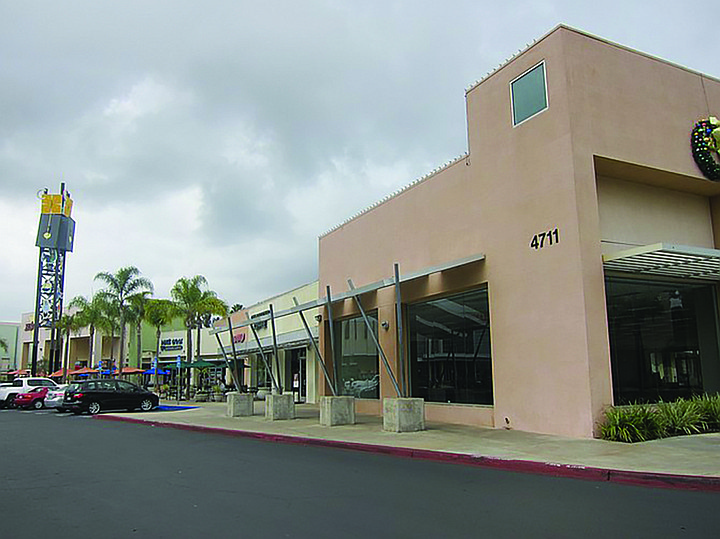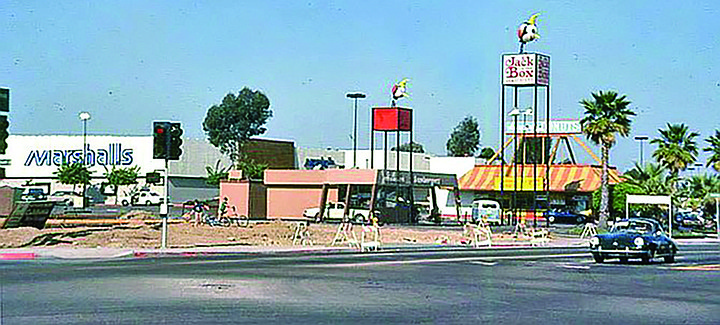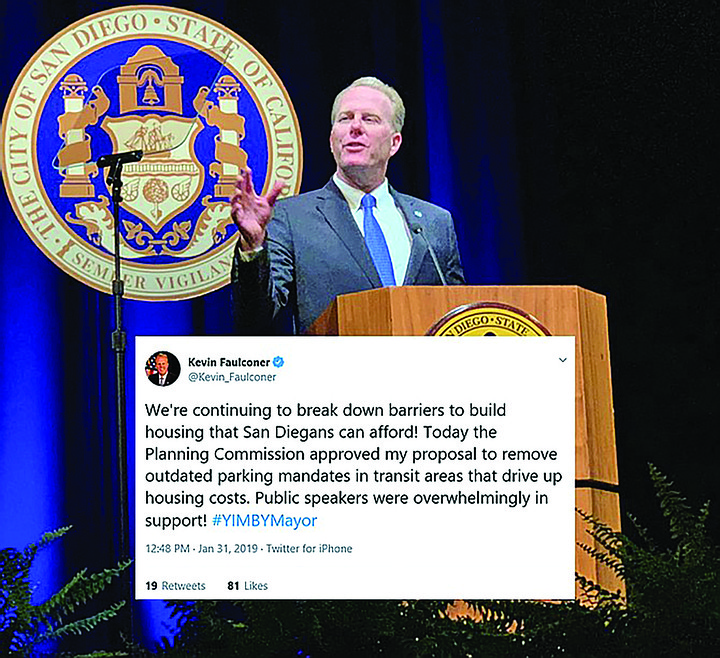 Facebook
Facebook
 X
X
 Instagram
Instagram
 TikTok
TikTok
 Youtube
Youtube

Our mayor has a dream, a dream in which NIMBYs click their heels three times and turn into YIMBYs joyfully proclaiming, “Yes, in my backyard.” In this perfect world, constituents no longer have any anti-housing bias. Gone are the days of buzz kills such as height and density maximums, the need for parking spaces, or demands for unnecessary hearings and appeals.
But the mayor’s KumbaYIMBY will be a tough sell. Especially to Clairemont residents who mostly live in single-family-home neighborhoods and don’t fancy increased population density. To test the waters, the city rolled out a new online tool on February 13 to gauge where communities are willing to put more housing density. Clairemont is the first to give this tool a go. The city’s eyes are focused on area shopping centers, which are in decline, and planned trolley stations along Morena Boulevard.

Back in December, Lightnin Jack’s BBQ called it quits after more than a decade in the Clairemont Town Square. Rumors followed about the upcoming demolition of the 1950s shopping center to build high-rises.
A former long-term tenant ousted from Clairemont Town Square after decades told me that more businesses will likely face the same fate. Current tenants have “seen the plans in the works for a complete redo including apartments, restaurants, and shops. It will definitely change the face of the neighborhood. I think they want a downtown multi-use type thing.” Because of this more “leases are being given month-to-month or short-term.”
“I tried to negotiate a move to another spot in the shopping center but was unable to. I’m afraid even if merchants find a new spot, the cost of moving and all modifications make it cost prohibitive. I myself went through every penny I had trying to find a new spot. I am now renting a room from a family member and am on social security. I’m sure the apartments they’ll put up will be cost-prohibitive to most current residents of the area.”

A current tenant said the shopping center is owned by a Ohio teacher’s pension fund. She said jacking up rents isn’t why tenants like Lightnin Jack’s are leaving, it’s that “almost everyone is on a short-term lease. No one wants to rent short-term, no one wants to go in for less than a five-year lease.” She said there are spaces in the center that management isn’t even trying to rent anymore, because they have plans of tearing them down.
She said the owners have a pretty aggressive plan to demolish and build high-rises. She said it’s going to be tough for the smaller merchants, even those with long-term leases will likely be moved from their current good locations to worse ones to make room for bigger names. She said the revamp is so the owners can charge big rent like University Town Center. More than one person I talked to said they don’t want to be the next University City.

When asked about the owner’s plans to build housing in the shopping center, Kelly Johnson (shopping center’s management) replied, “Not familiar with anything like that.” She ended our conversation after I asked about Lightnin Jack’s.
The State Teachers Retirement System of Ohio’s website has the Clairemont Town Square listed as one of their $72.9 billion in assets. Ohio’s pension system has been in the news the last few years because of financial woes.
Arian Collins with city communications said they know of no current housing plans for the Clairemont Town Square shopping center or “any other existing shopping center properties within the Clairemont planning area.” He mentionaed a January 30 community workshop to look at potential locations for adding housing density in Clairemont, including in shopping centers. This is tied to Clairemont updating their 1989 community plan.
On January 30, I received notice that the workshop had been canceled and that in lieu of the workshop an online tool “coming soon” was to be used. One resident said this was the fourth meeting in a row the city had canceled. One concern is that delays may be tied to legislation meant to minimize public input.
Planning Director Mike Hansen emailed the local planning group apologizing for cancelling the workshop on such short notice. “Several new citywide housing reforms were announced at last month’s [mayoral] state of the city address, resulting in questions about how that would impact the planning process going forward. We chose to postpone the workshop until more specifics are available so the session is as productive and meaningful as possible.”
Per Collins, the online tool is meant to get broader input by including residents that don’t usually attend workshops. After community feedback is compiled from the online tool, Collins said another workshop will be scheduled to share the results and to get further feedback.
The online tool asks that users add 5000 new housing units to at least three of eight focus areas and to put at least 2000 of those near upcoming trolley stations.
I started with Focus Area 1 (Clairemont Town Square). Each focus area is divided into subareas with options to add zero to a lot of new housing.
For experimental purposes, I selected the highest density possible each time, adding 2242 new units to the Clairemont Town Square area. The shopping center had the lions share, giving a clue to how much density the city is comfortable with. I added 2885 units to the Genesee and Balboa commercial area. Even though I surpassed the asked for 5000 units, I was reminded I still needed to add 2000 more near future trolley stations. After adding the maximum allowed density to all trolley stations and remaining commercial areas, I ended up with 10,210 new housing units.
When submitting my feedback, I was only asked for my age range, ethnicity, and whether or not I lived or worked in Clairemont. Could I vote again to add the highest densities possible? Yes, I was able to do that easily.
What wasn’t so easy was voting for low or no new density. My third time wasn’t the charm as I wasn’t allowed to submit this feedback. Only after selecting the lowest options above zero was I able to submit my feedback of adding 3020 units (with zero near trolley lines).
It struck me that anyone that might financially benefit from more density could stack the deck by taking the survey repeatedly. One resident said the city admitted the lack of security features.
Some residents I surveyed found the online tool tedious and worried Clairemont’s older population would find it hard to navigate. Others were concerned it would pit neighborhood against neighborhood as everyone voted to keep density out of their own neighborhoods while cramming it into someone else’s. Some expressed irritation at being asked to add housing near them when one county project set to bring about 450 affordable housing units into their neighborhood wasn’t going toward the count. Many waited hours to state their opposition to this project at December’s planning commission hearing only to leave feeling unheard.
At a 2017 workshop, a planning commissioner told city staff they needed to stand up to communities like Clairemont. If they folded on Clairemont, the commissioner reasoned, it would make it harder to get density into smaller communities. As one commissioner commented: if Clairemont can’t take more density, who can?
It’s important to note that not one city planning commissioner lives in Clairemont. Nor do any city councilmembers, county board of supervisors members, or the city’s mayor.
A representative of the group Clairemont Cares said, “It is extremely frustrating that the city’s priorities appear to be with the profitability of the developers and not those who are most impacted by the developments - the residents. The city created the affordability crisis by allowing the developers to pay in lieu of fees and expect the taxpayers to just accept whatever happens in their community. It is ridiculous that the resident’s concerns are dismissed, belittled, and ignored.... Perhaps our city officials priorities should be focused on those paying taxes rather than placating developers. Force the 10-percent affordable housing on all projects, and retrofit existing projects. Opposition would disappear.”
To be fair, the single-family-home life residents are fighting to preserve wouldn’t exist if it weren’t for developers that chose Clairemont to build the largest post-WWII suburban community in the United States. But developers build because it’s a good return on their investment. Even those that strictly build affordable housing are making money. As one county planning commissioner said in 2018 about housing affordability: the market decides or it’s subsidized.
The reality of Clairemont heading to a future of fewer single-family homes, higher density is why one local has decided to pick her battles more carefully. “Just saying no is no longer an option. It didn’t work for Nancy Reagan’s drug war and it won’t work for stopping what’s about to happen here. We can either have it in commercial areas or in our residential neighborhoods. Pick your poison.”


Our mayor has a dream, a dream in which NIMBYs click their heels three times and turn into YIMBYs joyfully proclaiming, “Yes, in my backyard.” In this perfect world, constituents no longer have any anti-housing bias. Gone are the days of buzz kills such as height and density maximums, the need for parking spaces, or demands for unnecessary hearings and appeals.
But the mayor’s KumbaYIMBY will be a tough sell. Especially to Clairemont residents who mostly live in single-family-home neighborhoods and don’t fancy increased population density. To test the waters, the city rolled out a new online tool on February 13 to gauge where communities are willing to put more housing density. Clairemont is the first to give this tool a go. The city’s eyes are focused on area shopping centers, which are in decline, and planned trolley stations along Morena Boulevard.

Back in December, Lightnin Jack’s BBQ called it quits after more than a decade in the Clairemont Town Square. Rumors followed about the upcoming demolition of the 1950s shopping center to build high-rises.
A former long-term tenant ousted from Clairemont Town Square after decades told me that more businesses will likely face the same fate. Current tenants have “seen the plans in the works for a complete redo including apartments, restaurants, and shops. It will definitely change the face of the neighborhood. I think they want a downtown multi-use type thing.” Because of this more “leases are being given month-to-month or short-term.”
“I tried to negotiate a move to another spot in the shopping center but was unable to. I’m afraid even if merchants find a new spot, the cost of moving and all modifications make it cost prohibitive. I myself went through every penny I had trying to find a new spot. I am now renting a room from a family member and am on social security. I’m sure the apartments they’ll put up will be cost-prohibitive to most current residents of the area.”

A current tenant said the shopping center is owned by a Ohio teacher’s pension fund. She said jacking up rents isn’t why tenants like Lightnin Jack’s are leaving, it’s that “almost everyone is on a short-term lease. No one wants to rent short-term, no one wants to go in for less than a five-year lease.” She said there are spaces in the center that management isn’t even trying to rent anymore, because they have plans of tearing them down.
She said the owners have a pretty aggressive plan to demolish and build high-rises. She said it’s going to be tough for the smaller merchants, even those with long-term leases will likely be moved from their current good locations to worse ones to make room for bigger names. She said the revamp is so the owners can charge big rent like University Town Center. More than one person I talked to said they don’t want to be the next University City.

When asked about the owner’s plans to build housing in the shopping center, Kelly Johnson (shopping center’s management) replied, “Not familiar with anything like that.” She ended our conversation after I asked about Lightnin Jack’s.
The State Teachers Retirement System of Ohio’s website has the Clairemont Town Square listed as one of their $72.9 billion in assets. Ohio’s pension system has been in the news the last few years because of financial woes.
Arian Collins with city communications said they know of no current housing plans for the Clairemont Town Square shopping center or “any other existing shopping center properties within the Clairemont planning area.” He mentionaed a January 30 community workshop to look at potential locations for adding housing density in Clairemont, including in shopping centers. This is tied to Clairemont updating their 1989 community plan.
On January 30, I received notice that the workshop had been canceled and that in lieu of the workshop an online tool “coming soon” was to be used. One resident said this was the fourth meeting in a row the city had canceled. One concern is that delays may be tied to legislation meant to minimize public input.
Planning Director Mike Hansen emailed the local planning group apologizing for cancelling the workshop on such short notice. “Several new citywide housing reforms were announced at last month’s [mayoral] state of the city address, resulting in questions about how that would impact the planning process going forward. We chose to postpone the workshop until more specifics are available so the session is as productive and meaningful as possible.”
Per Collins, the online tool is meant to get broader input by including residents that don’t usually attend workshops. After community feedback is compiled from the online tool, Collins said another workshop will be scheduled to share the results and to get further feedback.
The online tool asks that users add 5000 new housing units to at least three of eight focus areas and to put at least 2000 of those near upcoming trolley stations.
I started with Focus Area 1 (Clairemont Town Square). Each focus area is divided into subareas with options to add zero to a lot of new housing.
For experimental purposes, I selected the highest density possible each time, adding 2242 new units to the Clairemont Town Square area. The shopping center had the lions share, giving a clue to how much density the city is comfortable with. I added 2885 units to the Genesee and Balboa commercial area. Even though I surpassed the asked for 5000 units, I was reminded I still needed to add 2000 more near future trolley stations. After adding the maximum allowed density to all trolley stations and remaining commercial areas, I ended up with 10,210 new housing units.
When submitting my feedback, I was only asked for my age range, ethnicity, and whether or not I lived or worked in Clairemont. Could I vote again to add the highest densities possible? Yes, I was able to do that easily.
What wasn’t so easy was voting for low or no new density. My third time wasn’t the charm as I wasn’t allowed to submit this feedback. Only after selecting the lowest options above zero was I able to submit my feedback of adding 3020 units (with zero near trolley lines).
It struck me that anyone that might financially benefit from more density could stack the deck by taking the survey repeatedly. One resident said the city admitted the lack of security features.
Some residents I surveyed found the online tool tedious and worried Clairemont’s older population would find it hard to navigate. Others were concerned it would pit neighborhood against neighborhood as everyone voted to keep density out of their own neighborhoods while cramming it into someone else’s. Some expressed irritation at being asked to add housing near them when one county project set to bring about 450 affordable housing units into their neighborhood wasn’t going toward the count. Many waited hours to state their opposition to this project at December’s planning commission hearing only to leave feeling unheard.
At a 2017 workshop, a planning commissioner told city staff they needed to stand up to communities like Clairemont. If they folded on Clairemont, the commissioner reasoned, it would make it harder to get density into smaller communities. As one commissioner commented: if Clairemont can’t take more density, who can?
It’s important to note that not one city planning commissioner lives in Clairemont. Nor do any city councilmembers, county board of supervisors members, or the city’s mayor.
A representative of the group Clairemont Cares said, “It is extremely frustrating that the city’s priorities appear to be with the profitability of the developers and not those who are most impacted by the developments - the residents. The city created the affordability crisis by allowing the developers to pay in lieu of fees and expect the taxpayers to just accept whatever happens in their community. It is ridiculous that the resident’s concerns are dismissed, belittled, and ignored.... Perhaps our city officials priorities should be focused on those paying taxes rather than placating developers. Force the 10-percent affordable housing on all projects, and retrofit existing projects. Opposition would disappear.”
To be fair, the single-family-home life residents are fighting to preserve wouldn’t exist if it weren’t for developers that chose Clairemont to build the largest post-WWII suburban community in the United States. But developers build because it’s a good return on their investment. Even those that strictly build affordable housing are making money. As one county planning commissioner said in 2018 about housing affordability: the market decides or it’s subsidized.
The reality of Clairemont heading to a future of fewer single-family homes, higher density is why one local has decided to pick her battles more carefully. “Just saying no is no longer an option. It didn’t work for Nancy Reagan’s drug war and it won’t work for stopping what’s about to happen here. We can either have it in commercial areas or in our residential neighborhoods. Pick your poison.”
Comments